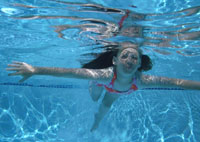Umbra,
I recently managed to mangle my knee and am going through all the 4,673 steps necessary to unmangle it and make it happy and functional again. One of the things my doctor advised me to do was swim. Well, swimming pools are of course full of chlorine! Hey, I just bought an expensive filter for my shower to keep the chlorine off the largest organ of my body, my skin. So what are the risks of contact with chlorinated water such as in a shower or a swimming pool?
Vincident
Dearest Vincident,
Your question made quite a splash here at Grist, where the staff consists entirely of water polo players, triathletes, and synchronized swimmers. (In fact, we secretly want to use the moola from our recent fundraiser to build an indoor pool next to our offices.) I dove right into the research, and as it turns out, the truth hurts worse than my puns.

Practicing our rocket split.
As you know, chlorine is used to remove harmful contaminants from water, mostly because it’s cheap. When chlorine reacts with organic matter such as dirt, dandruff, and limes, a whole new nasty family of chemicals results: trihalomethanes. THMs then float around in the water and in the air — many more in the pool than in the shower. The concentration of THMs depends on water temperature and the amount of chlorine in the pool. Chloroform is the most notorious THM, classified as a likely carcinogen by the U.S. Department of Health and Human Services. That means scientists fed it to rodents and the rodents got liver and kidney cancer, or, if they were pregnant, they sometimes miscarried or had defective rodent babies. Sounds bad.
When swimming in chlorinated water, you have an elevated exposure to this family of chemicals. As you might expect, the actual risks from such exposure are currently unknown. Research questions include: Can you absorb a significant amount of THMs through your skin, or is swallowing water the biggest danger? Do pregnant women need to be concerned? How long do THMs persist in the body? In the case of chloroform, at least, the answer appears to be: not very long. The U.S. Occupational Safety and Health Administration has set allowable workplace chloroform levels for the standard work week at 50 parts per million. Most pool air will be at that level or higher, but you are only in the pool for an hour or so.
In short, I would venture that the amount of swimming you’ll do to rehabilitate your knee won’t destroy the rest of you. Sure, you could still wind up having defective rodent babies, but don’t let that send you off the deep end. Swimming is great exercise, and your knee is a vital joint that has to last the rest of your life.
Swimmingly,
Umbra

